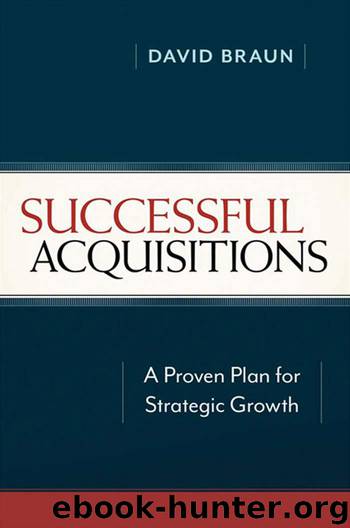Successful Acquisitions: A Proven Plan for Strategic Growth by David Braun

Author:David Braun [Braun, David]
Language: eng
Format: mobi
ISBN: 9780814432662
Publisher: AMACOM
Published: 2013-04-09T14:00:00+00:00
CONTACT STRATEGY
Before people from your company begin to speak to owners, you need to determine a contact strategy based around three key points: whom you are contacting from the prospect’s organization, who is making the contact on behalf of your organization, and the method of approach.
Assuming your research has brought you to the point of initiating a connection, you should have an idea of whom to call first at the prospect company. Needless to say, this can be more complicated than simply asking to speak with “the owner.” Companies can have multiple owners or an owner who is only passively involved in the business. You may need to make multiple contacts and carry on separate dialogues with several different people in the same target company.
As to who should be making the first contact, it may seem intuitive that when contacting an owner, the best person in your organization to make the call is your own CEO, who may even know the individual in question. In Chapter 4, I laid out a limited role for the CEO in the acquisition process, with carefully defined responsibilities. In this spirit, I caution against the CEO being the one to first make contact with an owner. Having a preexisting relationship with an owner can actually create an awkward situation as you start to ask probing questions about the target company from a buyer’s point of view.
Instead, it’s often a wise idea to have your adviser make the initial contact. Here’s one instance where the use of a third party makes particular sense. An outside consultant can maintain your anonymity at this exploratory stage, interviewing owners to gauge their attitudes toward a potential partnership. If, after these initial calls, you decide that you do not want to continue with a particular company, they will be none the wiser. If you do wish to proceed, you can then reveal yourself on your terms.
Third-party experts can also bring their years of experience in contacting owners and discovering their hot buttons. It takes considerable skill to quickly catch an owner’s interest, extend the conversation, and identify the underlying issues. So when you have only one chance to make a good first impression, it helps to have someone at your side who has been in that situation many times before. The probing questions that may cause an awkward situation between CEOs are expected from third parties, and prospects are more likely to open up to them. Just as you may not tell all of your health problems to your friends, you would have no problem explaining them to a doctor—an outside expert.
You may have noticed that in discussing the initial contact, I refer to making a phone call. This may seem unremarkable, but I have found that the idea of contacting owners by phone is actually somewhat unusual. I estimate that 85 percent of third-party advisers, including investment bankers, first contact a prospect by letter. While this option may be less costly in time, you get what you pay for.
Download
This site does not store any files on its server. We only index and link to content provided by other sites. Please contact the content providers to delete copyright contents if any and email us, we'll remove relevant links or contents immediately.
Hit Refresh by Satya Nadella(8854)
The Compound Effect by Darren Hardy(8508)
Change Your Questions, Change Your Life by Marilee Adams(7372)
Nudge - Improving Decisions about Health, Wealth, and Happiness by Thaler Sunstein(7242)
The Black Swan by Nassim Nicholas Taleb(6763)
Deep Work by Cal Newport(6563)
Daring Greatly by Brene Brown(6222)
Rich Dad Poor Dad by Robert T. Kiyosaki(6174)
Principles: Life and Work by Ray Dalio(5961)
Man-made Catastrophes and Risk Information Concealment by Dmitry Chernov & Didier Sornette(5646)
Playing to Win_ How Strategy Really Works by A.G. Lafley & Roger L. Martin(5499)
Digital Minimalism by Cal Newport;(5389)
Big Magic: Creative Living Beyond Fear by Elizabeth Gilbert(5351)
The Myth of the Strong Leader by Archie Brown(5237)
The Slight Edge by Jeff Olson(5200)
Discipline Equals Freedom by Jocko Willink(5157)
The Motivation Myth by Jeff Haden(5003)
Stone's Rules by Roger Stone(4857)
The Laws of Human Nature by Robert Greene(4773)
